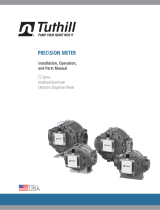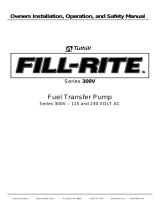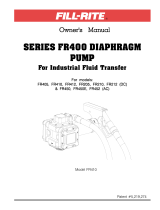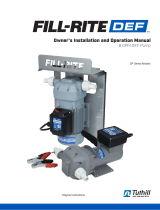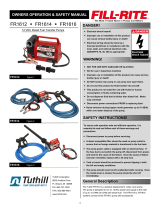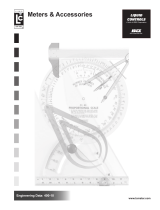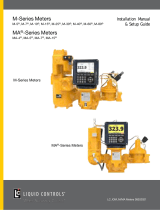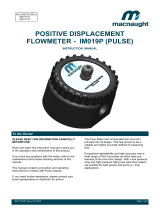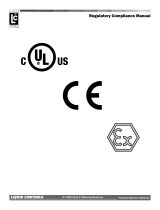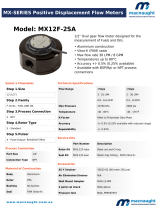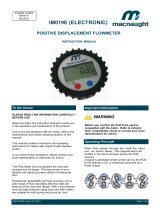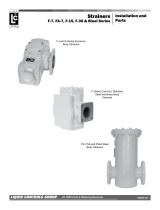Page is loading ...

Installation, Operation,
and Parts Manual
TM Series
Electronic

P (800) 634-2695 • (260) 747-7524
F (800) 866-4861
8825 Aviation Drive
Fort Wayne, Indiana 46809
Manufacturing Facility located in Fort Wayne, IN
Our manufacturing facility is
ISO 9001:2008 and Atex Certied
About Tuthill Precision Meters...........................................................1.3
Principle of Operation.........................................................................1.3
Fluid Compatibility..............................................................................1.3
Meter Specications and Model Capacity.........................................1.4
Safety Instructions..............................................................................1.5
Installation and System Recommendations........................................1.5
Start-Up Procedure............................................................................1.6
Flow Meter Calibration and Re-calibration..........................................1.6
Trouble Shooting the Flow Meter........................................................1.7
Trouble Shooting and Replacing the Sensor: Hall Effect ....................1.8
Reed Switch................1.9
Quadrature................1.10
Wiring Diagrams:
CC56 & CC56/PIA-300 ................................................1.11
PIA-300 and Fuel Sentry Systems ................................1.12
PC58/PCDT58 and PC58/PCDT58 with 4.20mA.........1.13
ELNC & ELNC/Backlight and Pulse ........................... 1.14
EL2057/ELNC ............................................................ 1.15
SCL/EMR3 Register ................................................... 1.10
Control Drawing for Pulsers ............................................................ 1.16
Parts List:
Model TM02D ................................................................. 2.1
Models TM03A and TM03D ............................................ 2.2
Models TM04 A and TM04D ........................................... 2.3
Models TM06A and TM06D ............................................ 2.4
Specications for PIA-300 (optional Signal Conditioner) ................... 3.1
Application Check List for Future Applications .................................. 3.3
Tuthill Corporations humble beginnings date back to 1892, when
James B. Tuthill purchased a clay quarry and a kiln and began
supplying Chicago common bricks to local construction rms. In the
early 1920’s, his efforts to improve lifting clay from the quarry turned
up a new transportation idea—a steam-powered truck engine.
The design eventually proved unworkable, but Tuthill recognized the
value of the engine’s small, internal gear pump, which injected fuel
oil directly into the truck boiler. The pump design was rened and
was marketed to companies that produced oil-red boilers for use in
residential and industrial heating, where it enjoyed great success and
formed the basis on which the Tuthill Pump Company was formed.
Over 120 years and ve generations later, Tuthill Corporation is a
global presence in vacuum pumps, blowers, plastics, and fuel and
chemical transfer systems. We take great pride in our “Made in USA”
moniker, making quality and durability top priorities. Tuthill Precision
Meters carry that legacy and competency in uid transfer products
to new levels. Our patented “Wave Form” gears provide extreme
accuracy through strict control of uid slippage in the metering
chamber, and our electronics work with virtually any metering or
management system.
Your choice of a Tuthill Precision Meter is an investment in
professional equipment that will pay dividends for years to come.
We appreciate your business, and look forward to serving you in the
future!

About Tuthill Precision Meters
We thank you for purchasing a Tuthill product for liquid
measurement service. Formerly known as Fluid Power Prod-
ucts, it is now a trade name of Tuthill Precision Meters. FPP
was established in 1980. Since its inception, the company
has been dedicated to manufacturing cost-effective, high
performance flow metering devices for petroleum, industrial,
commercial and municipal service.
Our facilities include computerized order entry and inventory
control, so that you are assured of accurate and prompt de-
liveries. Furthermore, our production personnel ensure that
each order, regardless of size, receives individual attention.
Constant attention to new product development and produc-
tion design, our high standards of manufacture and final
testing are the reasons why Tuthill Precision Meters meet
your most demanding requirements. With the ‘Waveform’
oval gear (2003 patent) meter accuracy is better than ever
before.
Our meters are used in batching, blending, process control
and to dispense fluids in liquid handling facilities throughout
the World. Service includes gasohol blends, bio-diesel and
special formulation racing fuels.
Principle of Operation
Positive Displacement meters have a measuring chamber,
where inlet & outlet are separated by rotors, a rotating ele-
ment or sliding vanes. As the liquid passes through the flow
meter, it causes the rotors/element/vanes to turn, which
forms the basis for volumetric measurement.
The Oval Gear metering principle is based on two elliptical
(oval) gears, which turn on center on two horizontal shafts
inside a measuring chamber formed by two overlapping cyl-
inders. The oval gears have meshing teeth along their en-
tire circumference, ensuring that the gears will maintain cor-
rect position in relation to each other at all times, without the
use of timing gears.
The volume being transferred from the inlet to the outlet side
(= volume measured), forms between the oval gear and the
side of the measuring chamber, alternately in the upper and
the lower half of the measuring chamber. In a full 360° rota-
tion of the gears, four such known volumes are released to
the downstream side of the flow meter.
The flow meter is 100% gland-less with static O-ring seals
only. Internal magnets are detected by a sensor (pulser)
mounted in flow meter case. The pulser generates an elec-
trical on/off signal, which can be used to drive a signal con-
ditioner or an electronic register.
With precision machining and close internal tolerances, the
slippage is minimal for superior linearity (accuracy) over a
broad turn-down ratio. Oval gear meters are largely unaf-
fected by changes in liquid viscosity. In TM Series meters
we expect a shift of no more than 2-4% due to variations in
liquid viscosity between 1 and 100 cSt. As the viscosity
increases further, there is no noticeable change.
To ensure optimum linearity (accuracy), TM Series meters
should be field calibrated correct for individual meter varia-
tions, liquid viscosity and local system/operational factors.
Fluid Compatibility
Tuthill flow meters are available in anodized aluminum and
stainless steel, with a variety of rotor types and seals, to
ensure compatibility with a broad range of liquids. If in doubt
about compatibility with a a specific fluid, please refer to
Tuthill Precision Meter Technical Manual. If that publica-
tion does not provide a clear answer, please consult with
your authorized Tuthill Meter distributor, or Customer Care
at the factory.
While most refined petroleum products can be handled with
the same flow meter, some require different rotors and/or
seals. Do not change service liquid, without consulting with
your authorized FPP Meter distributor.
1 . 3
TM Series, Principle of Operation
Only 2 moving parts.
Patented ‘Waveform’ oval gears = sustained accuracy with a minimum of maintenance.
No metal-to-metal contact in measuring chamber or in bearings.
The lowest differential pressure values amongst rotary PD meters.
=> Lower Cost of Ownership!
TM04A
with RS pulser
= 1 magnet in 1 gear
TM04A
with HE pulser
= 4 magnets in gears
TM02D
with HE pulser
= 2 magnets in 1 gear

Materials:
TM●●A Case & cover : Anodized aluminum
Posts (shafts) : 316SS
Seal : Viton™ std., Teflon™ optional
TM●●C Case & cover* : 303SS
Posts (shafts) : 316SS
Seal : Teflon™ standard
TM●●D Case & cover* : 316SS
Posts (shafts) : 316SS
Seal : Teflon™ standard
Rotors (oval gears) : TM02 SS/Teflon bearings
TM03 PPS standard,
SS/Teflon bearings opt.
TM04 PPS standard
TM06 PPS standard
* Pulser retainer (exterior non-wetted fitting) is anodized aluminum.
Pressure Rating:
TM Series meters are manufactured with 2 different pres-
sure ratings (though not in all sizes/materials). Pressure
rating is identified in position 11 in the Part Number:
Pos. 11 in P/No. K L F obsolete 2009
1500 PSI 2500 PSI 400 PSI
MODEL 103 BAR 173 BAR 28 BAR
TM02D
TM03A
TM03D
TM04A
TM04C
TM04D
TM06A
TM06C
TM06D
Pressure rating applies to -40ºF/+100ºF (-40ºC/+38ºC) tem-
perature range. At higher operating temperatures the pres-
sure rating is reduced by factors shown below:
Temperature Rating:
TM Series meters are rated for use on liquids with tempera-
ture in -40ºF/+300ºF (-40ºC/+150ºC) range. This tempera-
ture rating applies to the flow meter only.
Electronic signal conditioner, totalizer or register attached to
the flow meter will have a different rating, which may differ at
both the low and high end of the range (refer to manual for
electronic components). When that is the case, the elec-
tronic component must be installed remote from the flow
meter.
Flow Meter Nominal Capacity:
TM02D 0.3 GPM 1.1 lpm
TM03 3.0 GPM 11 lpm
TM04 10 GPM 38 lpm
TM06 20 GPM 76 lpm
Actual capacity depends upon liquid lubricity, viscosity and
operating temperature. Normal turn-down is 10:1 from nom-
inal (maximum) value shown. Optimum performance is be-
tween 50% and 85% of nominal capacity.
When the viscosity exceeds 200 cSt, maximum flow rate is
restricted, but the flow meter will have satisfactory linearity
(accuracy) down to 2-3% of nominal capacity.
To determine model maximum capacity on higher viscosity
liquids, find the flow meter coefficient for maximum liquid
viscosity in table below, and multiply nominal capacity with
this factor.
1 . 4
-40°F/+100°F 150°F 200°F 225°F 250°F 275°F 300°F
-40°C/+100°C 66°C 93°C 107°C 121°C 135°C 150°C
A.A. 1.00 0.89 0.79 0.75 0.72 0.62 0.43
S.S. 1.00 0.91 0.83 0.79 0.74 0.70 0.67
On liquids with
1 cSt viscosity.
A E & K
1cSt 1.000 1.000 32 SSU
10 1.000 1.000 60
50 1.000 1.000 240
100 1.000 1.000 475
200 1.000 1.000 925
300 0.855 0.855 1,425
400 0.770 0.770 1,875
500 0.710 0.710 2,350
600 0.660 0.660 2,825
700 0.625 0.625 3,300
800 0.595 0.595 3,775
900 0.560 0.560 4,250
1,000 0.540 0.540 4,725
2,000 0.350 0.350 9,450
3,000 0.275 0.275
4,000 0.240 0.240
5,000 0.190 0.190
6,000 0.160 0.160
7,000 0.135 0.135
8,000 0.115 0.115
9,000 0.100 0.100
0.085
0.072
0.061
0.052
0.044
0.037
0.031
0.026
0.022
0.019
Rotor Code
60,000
70,000
80,000
Liquid
Viscosity
141,600
188,800
236,000
283,200
330,400
377,600
424,800
90,000
472,000
Liquid
Viscosity
Flow Meter Coefficient
100,000
10,000
20,000
30,000
40,000
50,000
14,150
18,875
23,600
28,325
94,400
33,050
37,750
42,475
47,200
TM Series, Specifications & Capacity

SAFETY INSTRUCTIONS
Make sure that all necessary safety precautions have been
taken, including proper clothing, personal safety equipment
and fire safety equipment if required.
Before Start-Up of the Flow Meter, make certain that:
1. The meter is properly mounted, secured and piped.
2. All connections are tight.
3. All bleed and drain valves are closed.
4. Do NOT smoke near meter, or use meter near an open
flame, when metering flammable liquids. Fire or Explo-
sion could result.
5. This meter is not intended for use on liquids, which re-
quire 3A Sanitary equipment for human consumption. It
may be used on edible liquids, which do not spoil easily,
such as vegetable oils, liquid sweeteners & similar.
Install the Flow Meter and Accessories in compli-
ance with all applicable Local, State & Federal
Construction, Electrical and Safety Codes.
Flush the system to remove all debris, scale and welding
slag prior to flow meter installation. If this is not possi-
ble, temporarily remove rotors (oval gears), and reinstall
after the system has been flushed.
Apply pipe compound to male threads. Do NOT use Tef-
lon tape.
Avoid pipe stress when installing the flow meter.
When installing the flow meter, consider future mainte-
nance of both flow meter and accessories. The meter
can be serviced in place, provided block (isolation) valves
are included, and adequate space allowed.
In critical installations a by-pass line is recommended,
so flow can continue while flow meter is being serviced.
Thermal relief valves are recommended, and should be
installed whenever it is possible to block (isolate) the flow
meter between two valves. The pressure rise in a closed
system, from just a few degrees increase in temperature,
can be many times normal working pressure.
Connections for calibration should be provided during
installation. An easy means for diverting flow into a cali-
bration vessel (or through a Master Meter) should be con-
sidered.
1 . 5
Installation
Positive Displacement meters are designed to operate full
of liquid. The meter should be installed in a manner, so
that it remains full of liquid at all times.
The flow meter is not designed to operate on air, but the
design and materials of construction allow for operation
on vapor for short periods of time without damage to the
oval gears or flow meter internals.
Hydraulic shock can be harmful to flow meter and other
system components. Consideration to eliminate hydraulic
shock should be given in selection of pump and design of
the piping system.
The flow meter can operate with liquid going Left-to-Right,
Right-to-Left or Vertical Up, but it must be installed with
rotor shafts in horizontal position (= with vertical end
covers). Failure to observe this will impact negatively on
flow meter accuracy.
Protective caps installed in flow meter flanges prior to
shipment should remain in place until you are ready to
install in the piping system.
It is recommended that a Strainer be installed upstream
of each flow meter, to prevent damage from foreign mat-
ter, such as welding slag, pipe scale or parts breaking off
other equipment.
Allow adequate space for removal of strainer basket
cover, so strainer basket can be cleaned.
OPERATING TEMPERATURE
TM Series meters are rated for operation from
-40°F/+300°F (-40°C/+150°C). However:
They are not suitable for cryogenic service.
When temperature exceeds +120°F (+50°C), ‘K’ ro-
tors must be used, and pressure rating is reduced.
Refer to FPP Technical Manual for details.
OPERATING PRESSURE
TM Series meters Maximum non-shock Operating
Pressure is (see position 11 in the P/No.):
Code F 400 PSI (= 10.3 BAR) at 100°F
Code K 1500 PSI (= 103 BAR) (+38°C).
Code L 2500 PSI (= 175 BAR)
The flow meter should never be operated in excess of
this pressure. Care should be taken to eliminate ther-
mal and hydraulic shock conditions, so that system
pressure never exceeds the flow meter’s Maximum
Working Pressure rating.
BYPASS
OPERATING
METER
TEMPORARY MASTER METER
THERMAL
RELIEF
TM Series, Start-Up & Operation

Frequency
TM Series meters are not intended for use in Custody
Transfer service, so Weights&Measures regulations should
not apply. If local authorities issue regulations for non-W&M
flow meters, such regulations must be observed.
If user is ISO9000 certified, user ISO standards will indicate
frequency of re-calibration for instrumentation. Those rules
should be observed. If no regulations or standards apply,
our recommendations are:
A. Calibrate immediately after installation.
B. Re-calibrate after 15-30 days.
C. Re-calibrate after 180 days and again after 360 days.
After the run-in calibration (B) and follow-up calibrations (C),
it is possible to evaluate degree of change under normal
operating conditions. Based on values found, and total vol-
ume being metered under normal operating conditions, de-
cide whether a 6, 12 or possibly 24 month schedule should
be adopted.
Procedures & Methods
Flow meters used in systems where the flow rate can fluctu-
ate, should be tested at minimum, intermediate & maximum
flow rates. In non-W&M service, a flow meter always oper-
ating at a steady flow rate, can be tested at that flow only.
All tests should be repeated 3 times to confirm repeatability.
All tests should be of at least 60 second duration, to mini-
mize effect of flow meter error during start-up & shut-down.
After calibrating a known volume (X) into an accurate
prover, or through a master meter, compare with register
reading (Y) and calculate correction:
When re-calibration has established that a correction is
required, change flow meter K Factor:
When prover/master meter reading is less than flow
meter register reading, add percentage calculated to
the original K Factor..
When prover/master meter reading is more than flow
meter register reading, subtract percentage calculat-
ed from the original K Factor.
Circulate product through the flow meter for a few
minutes. Then perform at least 3 more tests, to confirm
flow meter accuracy & repeatability.
If the flow meter does not repeat, it will likely require a
new set of rotors (oval gears).
Before ordering new gears, inspect the measuring
chamber for scratches or wear. If the measuring
chamber is scratched or scored beyond what can be
smoothed with emery paper, the flow meter should be
replaced.
Finally, enter date and % correction on the permanent
flow meter record.
1 . 6
Start-Up & Operation
Very slowly fill the system with liquid, to avoid operating the
flow meter on air or vapor. This can be accomplished in the
following manner:
1. Throttle the meter inlet valve, and allow the system to fill
slowly by gravity.
2. Crack open the outlet valve. Start the pump, and then
slowly crack open the inlet valve, filling the meter slowly
before fully opening the inlet and outlet valves.
In normal operations:
Avoid sudden changes in temperature.
Avoid sudden changes in flow rate.
Gradually increase or decrease the flow rate.
Flow Meter Calibration
It is recommended that written records be maintained on all
flow meters. These records should include:
Supplier and Service Department phone number.
Date of installation.
Details of maintenance performed.
Flow meter initial K Factor (number of pulses per unit of
volume).
Date & result of each re-calibration, with changes in flow
meter K Factor.
TM Series flow meters are given a functional ’Pass or Fail’
test prior to shipment, but written records of this test are not
maintained. The nominal K Factor shown on flow meter
cover is an average value, which should be used as a start-
ing point when field calibrating on actual liquid of operation.
Accuracy curves of individual flow meters vary some. Also,
the accuracy curve of all flow meters will shift due to varia-
tions in liquid viscosity; perhaps as much as 3-4% from 1 cSt
to 100 cSt. The accuracy curve will not shift significantly at
higher viscosities, even if the actual operating liquid has
viscosities up to 500,000 cSt.
Since we cannot test on actual fluid of operation, it is
the responsibility of the buyer to field calibrate in place
of service on actual operating liquid.
X - Y
X
x 100
= % correction
Nominal K Factor on 1 cP liquid
These values are subject to individual flow meter variation,
as well as expected fluctuation due to liquid viscosity (see
above).
HE pulser RS pulser
TM02 7700 PPG 2035 ppl 3750 PPG 1017 ppl
TM03 2800 PPG 740 ppl 700 PPG 185 ppl
TM04 805 PPG 213 ppl 201 PPG 53 ppl
TM06 405 PPG 107 ppl 101 PPG 27 ppl
Start-Up, Operation & Calibration

Breaking Teeth on Rotors (Oval Gears)
This is a sign of hydraulic shock conditions in the system.
Common sources:
Starting or stopping flow too rapidly. Replace dam-
aged components and correct operational practices.
Pump by-pass not adjusted properly. Re-adjust as
necessary.
Leakage from Cover
The seals (and possibly end covers) have been damaged
due to excessive pressure. There are two possible sources:
Starting or stopping flow too rapidly. Replace dam-
aged components and correct operational practices.
The flow meter is in a system, where it can be isolated
between two valves. Add a Thermal Relief Valve to
bleed off excess pressure when the temperature rises.
Installation, Maintenance & Service must be performed
by personnel:
A. Qualified to work on this type of equipment.
B. Familiar with all applicable local codes and ordi-
nances covering the type of service, where the flow
meter is used (gasoline, LPG, etc.).
Avoid pipe strain and stress when making flow meter re-
pairs. The weight of the pipe and the flow meter must be
supported independently. This allows the flow meter to be
serviced without affecting the alignment of piping.
Avoid prying or exerting heavy pressure on precision parts,
as this can affect the performance of the flow meter. Assure
that all machined parts are free of burrs and nicks. Stone all
machined surfaces if necessary to remove burrs.
Always coat bolt threads with an anti-seize or an appropriate
lubricant. This prevents thread damage, and assures that
proper torque values are applied during re-assembly. If
threads are damaged, repair using inserts.
Relieve All Internal Pressure Prior to Opening
Drain Liquid prior to Working on Flow Meter
Rinse with Neutral Liquid
prior to Seasonal Storage
Triple Rinse with Neutral Liquid
prior to Shipment for any reason.
1 . 7
No Flow
Blocked strainer basket. Clean the basket.
Faulty or non-functioning pump. Repair pump.
Valve stuck in closed position. Check and repair valves.
Flow meter ‘frozen’ due to build-up of chemical salts (or
frozen water) inside the measuring chamber. Clean the
flow meter (see page 1.8), and inspect for damage.
Meter jammed on a particle that has passed through a
damaged strainer basket. Remove particle and replace
rotors if necessary, replace strainer basket.
Reduced Flow Rate
Strainer basket partially blocked. Clean the basket.
Pump not functioning correctly. Repair pump.
Valve stuck in partially closed position. Check valves and
repair.
Meter rotors (oval gears) partially ‘salted’ with chemical
deposits, slowing the movement. Clean the meter (see
page).
Product Flows, but the register does not record
Check power supply to the register.
Check the connection between the pulser and the elec-
tronic register.
Check pulser output (see page 1.8). Replace if needed.
If product is flowing, and the flow meter is generating a
pulse signal, the problem is in the electronic register.
Please refer to the manual for the electronic register.
Product Flows, register does not record correctly
If error factor is constant, the flow meter is fine. The likely
cause is either:
Incorrect K Factor in the electronic register. Re-
calibrate the meter and correct the K Factor.
A constant problem with air getting into the system.
Review system design and control valves.
If the error is random, the likely cause is either:
Poor cable connections (insulation not trimmed, or
stray strands getting close to incorrect contacts). This
can be signal conditioner (if included) or where pulse
signal is connected to the register. Inspect and correct
connections as necessary.
Valve leaking, allowing a portion of the system to drain.
Check & repair valves.
An intermittent problem with air in the system, com-
bined with inadequate air elimination. Review system
design and control valves.
Interference from other electrical equipment nearby.,
possibly combined with sub-standard cables.
Prior to opening or disassembly of any flow meter, all internal pressure must be relieved and all liquid must be
drained. This must be done in accordance with applicable company and local codes & ordinances.
Make sure that all necessary safety precautions have been taken, including proper clothing, personal safety equip-
ment and fire safety equipment if required.
Trouble Shooting & Service

To install a new sensor, look at the top of the replacement
sensor. An internal PC board is visible through the epoxy
(usually protrudes slightly from the epoxy). This PC board
must be aligned parallel with a line drawn between flow
meter inlet and outlet.
Close-Up
Trouble Shooting the Sensor
There are three components to be examined to determine
why there is no pulse count coming from the flow meter:
1. Flow meter with magnets in the oval gears.
Verify that liquid is flowing.
Verify that sensor (pulser) cable is intact.
2. The sensor (pulser)
Remove the sensor from the flow meter. Expose
the black & white leads (in dual signal sensors, also
the green lead). This can be done at a convenient
junction, or at the register.
Use an volt meter to measure the voltage between
the white & black leads. It should be nearly equal to
the power supply voltage provided on the red lead.
Pass a magnet across the tip of the sensor. The
voltage must switch to nearly zero (less than 0.2 V).
If the magnet does not actuate the sensor, the sen-
sor has failed.
For two channel sensors, repeat this test across
black & green leads.
3. The counter (or receiving instrument)
If liquid is flowing, and the sensor reacts to a mag-
net, the problem is in the counter/receiving instru-
ment (or possibly in a signal conditioner installed
between the sensor & counter/receiving instrument.
Please refer to the manual for the this device.
See Control Drawing on page 1.10
Intrinsically Safe rated sensors for
Cl. 1, Div. 1, Grp. D and Zone 0 applications
CD1002, UL 9HA6, DEMKO 04 ATEX0334817 EEx ia IIA T4
The standard sensor (pulser) is a Hall Effect device, which
may have one or two output signals. To retain above ratings,
it must be powered from a secure circuit through an approved
barrier. A PIA-300 signal conditioner may be required, when
connected to non-FPP electronics
Specifications:
Operating speed : 0-100 kHz.
Operating temperature : -40ºF/+300ºF (-40ºC to +150ºC)
Supply voltage : 4-28 VDC
Supply current : 13.5 mA max.
Output type : SINK (add PIA-300 for source)
Output voltage @ 20 mA: 0.40 V max
Output sink current : 20 mA max
Leakage current : 10 μA max
Magnetics type : Bipolar, operated with alternat
ing north & south magnetic
poles.
Internal pull-up resistor : 10KΏ
Transmission distance : Max. 100’ (30 m) without PIA-300
Pull-up Resistor (R1 & R2)
The sensor has one internal 10KΏ pull-up resistor for each
output signal. If used directly with non-Tuthill electronics,
verify whether this is adequate for solid communications.
Cable
24 AWG, foil shield & drain wire, blue PVC jacket, RoHS.
75VDC. Capacitance: 185 nF/km. Inductance: 0.65 mH/km.
Standard with 18” (45 cm) leads. 120” (305 cm) or
480” (1220 cm) leads optional.
Color Code:
Red Positive, 4-28VDC
Black Negative (signal common)
White Signal output A
Green Signal output B (optional)
3 conductor: Standard Hall Effect sensor
4 conductor: Dual signal Hall Effect sensor (Quadrature)
2 conductor: Optional Reed Switch sensor (see page 1.9).
A PIA-300 amplifier is required for cable lengths exceeding
100’ (30 m).
Easy Identification of replacement sensors
Black anodized housing is for
TM04 & TM06 models.
Metallic finish is for use in
TM02 & TM03 models
Installation
Do NOT remove the sensor (pulser) from the flow meter,
unless trouble shooting has indicated a problem in the sen-
sor. To remove the sensor, loosen the lock nut on the sen-
sor retainer (sensor well in model TM06). The sensor can
now be pulled out.
CAUTION
If the sensor is
connected incorrectly,
it will be damaged
beyond repair.
PC board
PC board
I N L E T
1 . 8
Hall Effect Sensor (Pulser)

When powered through an approved barrier, Reed Switch
sensors are Intrinsically Safe.
Trouble Shooting the Sensor
CAUTION: Do NOT use an Ohm-meter to test
the reed switch sensor (pulser).
Remove the sensor from the flow meter, and expose the
red & black leads. This can be done at a convenient junc-
tion, or at the register.
Measure the voltage between the red & black leads. It
should be equal to the voltage provided by the register.
Pass a magnet across the tip of the sensor, the voltage
should switch to zero (less than 0.2 V).
If the magnet cannot activate switching of the sensor, then
the sensor has failed and must be replaced. There are no
alignment requirements for the Reed Switch sensor.
1 . 9
Reed Switch
This sensor is strictly for use with battery powered stand
-alone registers, where no external power source is avail-
able. If external power is available, Hall Effect pulser
should be used - even when the register is battery pow-
ered.
In so called ‘pulse meter’ service, either Hall Effect or
Quadrature Hall Effect pulser must be used - depending
upon the requirements of the receiving instrument.
The Reed Switch sensor (pulser) consists of a set of con-
tacts, hermetically sealed in a glass tube, protecting the con-
tacts from dirt and corrosion of the the outside world. Con-
tacts are actuated by an external magnetic field, provided by
permanent magnets inside the rotors.
This is a mechanical device with a finite life. To extend pulser
life, flow meters with Reed Switch pulser are only available in
‘low resolution’ version.
When the pulser starts to wear out, it rarely fails instantly.
Instead it starts to miss pulses. We recommend that the flow
meter be recalibrated on a regular basis. Once pulser failure
is detected, establish a schedule for pulser replacement as a
matter of normal maintenance.
Contact Rating:
Volts DC max. : 30 VDC
Amps DC max. : 0.01 A
Watts DC max. : 0.25 W
Initial resistance : 1.0 Ώ
Operating Temp range : -40ºF/+300ºF (-40ºC/+150ºC)
D-Must operate : 0.125” (3.2 mm)
D-Must release : 0.400” (10.2 mm)
Cable specifications:
24 AWG, foil shield & drain wire, blue PVC jacket, RoHS.
75VDC. Capacitance: 185 nF/km. Inductance: 0.65 mH/
km.
Standard with 18” (45 cm) leads. 120” (305 cm) optional.
BLACK
RED
Optional Sensors (pulsers)

1 . 10
Optional Quadrature Signal
When a TM Series flow meter is to be used with an electronic
register requiring dual channel signal (Quadrature signal), the
SCL signal conditioner is used. This produces a simulated
Quadrature signal for the register, which will record volume
correctly, but it does not permit detection of reverse flow.
The SCL is voltage specific. The standard version can be
field selected for 5VDC regulated, or 6-12VDC non-regulated.
An optional version is available for 24VDC service.
The SCL can be mounted:
In a separate enclosure inside the case of the primary
register (such as the EMR3 electronic register).
In a NEMA 4X enclosure, either mounted on the flow
meter, or installed remote.
In a NEMA 7/4X enclosure, either mounted on the flow
meter, or installed remote.
SCL wired to EMR3 register

1 . 11
Wiring Diagrams
HE pulser (DC powered) to CC56 register (battery powered)
HE pulser (DC powered) to PIA-300 with
Channel A to CC56 register, Channel B = pulse output to ??

1 . 12
Wiring Diagrams
HE pulser in ‘Fuel Sentry’
HE pulser (DC powered) to
PIA-300 pulse Isolator/Amplifier/Splitter

1 . 13
Wiring Diagrams
HE pulser to PC58 or PCDT58 with 4-20 mA Analog signal
HE pulser to PC58 or PCDT58

1 . 14
Wiring Diagrams
HE pulser to ELNC
HE pulser to ELNC with Backlight & 10:1 pulse out

1 . 15
Wiring Diagrams
HE pulser with EL2057 & ELNC for use in Hazardous Zone

1 . 16
Control Drawing
Cc = 60 pF/ft.>[200pF/m],Lc=0.2uH/ft [1µH/m]
EL8581-HE
EL8581-RS
CLASS I, DIV. 1, GROUP D T4
II 1 G Ex ia IIA T4 Ga
II 1 G
DEMKO 04 ATEX 0334817X
-20°C< Ta < +40° C
1725

2 . 1
TM02D Parts List
2009: 400 PSI (28 BAR) version being phased out 400 PSI 1500 PSI
REF Description QTY 28 BAR 103 BAR
1. Meter cover plate 1 CP86502 CP8625
2. Screw , cover plate (10-32 X 3/8" SHCS 303SS) 4 FS9651
Screw , cover plate (10-32 X 5/8" ALSTSHCS) FS1660
3. Meter body w ith posts, 1/4" NPT ports 1
Meter body w ith posts, 1/4" BSP ports
4. O-ring, cover plate, Teflon 1
5. Pulser retainer ('Top Hat') 1
6. Screw , pulser retainer (8-32 x 1" SHCS SS) 2
7. Lock nut 1
Standard pulser/gear set:
8.
Standard Hall Effect sensor (pulser).
When used with non-FPP electronics, a PIA-300 signal
conditioner is often required.
9. Gear set: SS/Teflon bearings, 2 magnets
Nominal K Factor: 7700 PPG (2035 ppl)
Optional pulser/gear set:
8.
Optional reed sw itch sensor (pulser),
For use with FPP battery powered electronic register
9. Gear set: SS/Teflon bearings, 1 magnet
Nominal K Factor: 3850 PPG (1018 ppl)
M M 02 P 2009-06
K Factor (pulse resolution) is nominal . Individual flow meters vary, and are
subject to up to 3-4% shift on liquids w ith viscosity > 100 cSt.
1
GSTM02-2
1
EL5300-HE
1
GSTM02-1
1
EL5300-RS
TM02D
MP2084
MP2541
FS9540
MB99011
MB99021
SL2029
Stainless Steel
When used with non-Tuthill electronics, a PIA-300 signal
conditioner is often required.
For use with Tuthill battery powered electronic register.

2 . 2
TM03A & TM03D Parts List
2009: 400 PSI (28 BAR) version being phased out 400 PSI 1500 PSI 400 PSI 1500 PSI
REF Description QTY 28 BAR 103 BAR 28 BAR 103 BAR
1. Meter cover plate 1 CP2800 CP2850 CP9800 CP9650
2. Screw , cover plate (10-32 X 3/8" SHCS 303SS) 6 FS9651 FS9651
Screw , cover plate (10-32 X 5/8" ALSTSHCS) FS1660 FS1660
3. Meter body w ith posts, 3/8" NPT ports 1
Meter body w ith posts, 3/8" BSP ports
4. O-ring, cover plate, Viton 1
O-ring, cover plate, Teflon
5. Pulser retainer ('Top Hat') 1
6. Screw , pulser retainer (6-32 x 1.1/2" SNCS SS) 4
7. Lock nut 1
8.
Hall Effect sensor (pulser). 1 EL5300-HE
9. PPS, Low viscosity/temperature Nom. 2800 PPG (740 ppl) 1 GS530R2600 (std. 2009+)
Gear Nom. 1400 PPG (370 ppl) GS530R1300 (std. pre-2009)
Set PPS, High Temperature (or high viscosity) Nom. 2800 PPG (740 ppl) GS530RMV2600 (optional)
Nom. 1400 PPG (370 ppl) GS530RMV1300 (optional)
SS gears w ith Teflon bearing Nom. 2800 PPG (740 ppl) GSTM03CT-4 (optional)
Low viscosity/any temperature Nom. 1400 PPG (370 ppl) GSTM03CT-2 (optional)
8.
Reed Sw itch sensor (pulser), 1 EL5300-RS (optional)
9. PPS, Low viscosity/temperature Nom. 700 PPG (185 ppl) 1 GS530R650 (optional)
Gear PPS, High Temperature (or high viscosity) Nom. 700 PPG (185 ppl) GS530RMV650 (optional)
Set SS gears w ith Teflon bearing Nom. 700 PPG (185 ppl) GSTM03CT-1 (optional)
M M 03 P 2009-06
MP2085
Stainless Steel
For use with FPP battery powered electronic register
When used with non-FPP electronics, a PIA-300 signal conditioner is often required.
na
SL2033
SL2033 (opt.)
SL1033 (std.)
FS9450
MS2541
MS2541
K Factor (pulse resolution) is nominal . Individual flow meters vary, and are subject to up
to 3-4% shift on liquids w ith viscosity > 100 cSt.
MP2085
FS9450
TM03A
TM03D
MB2800-21
MB2801-21
MB980021
MB980121
Anod. Aluminum
When used with non-Tuthill electronics, a PIA-300 signal conditioner is often required.
For use with Tuthill battery powered electronic register.

2 . 3
TM04A, TM04C & TM04D Parts List
TM04C
303 SS
400 PSI 1500 PSI 2500 PSI 400 PSI 1500 PSI
REF Description QTY 28 BAR 103 BAR 173 BAR 28 BAR 103 BAR
1. Meter cover plate 1 CP2501 CP2506C CP8575 CP9500 CP9501
2. Screw , cover plate (1/4-20 x 1/2 SHCS, SS) 4 FS9812 FS9812
Screw , cover plate (1/4-20 x 5/8 SHCS) FS1802 FS1802
FS1901
3. Meter body w ith posts, 1/2" NPT ports 1 MB8575-1
Meter body w ith posts, 1/2" BSP ports
4. O-ring, cover plate, Viton 1
O-ring, cover plate, Teflon SL2138
5. Pulser retainer ('Top Hat') 1 MP8550
6. Screw , pulser retainer (8-32 x 1" SHCS SS) 4 FS1901
7. Lock nut 1 MP2541
8.
Hall Effect sensor (pulser). 1 EL5581-HPHE
9. PPS, Low Viscosity/Temperature
Nom. 805 PPG (213 ppl)
1 (std. 2009+)
Gear Nom. 403 PPG (106 ppl) (std. pre-2009)
Set PPS, High Temperature (or high viscosity) Nom. 805 PPG (213 ppl) (optional)
Nom. 403 PPG (106 ppl) (optional)
8.
Reed Sw itch sensor (pulser), 1 EL5581-HPRS (optional)
9. PPS, Low Viscosity/Temperature 1 GS540R190 (optional)
PPS, High Temperature (or high viscosity) GS540RMV190 (optional)
M M 04 P 2009-06
2009: 400 PSI (28 BAR) version being phased out
For use with FPP battery powered electronic register
When used with non-FPP electronics, a PIA-300 signal conditioner is often required.
Anod. Aluminum
316 Stls. Steel
GS540RMV380
GS540RMV760
MB95011
MB95021
na
K Factor (pulse resolution) is nominal . Individual flow meters vary, and are subject
to up to 3-4% shift on liquids w ith viscosity > 100 cSt.
SL2138 (opt.)
SL2138
MP2086
FS9812
FS9812
MS2541
MS2541
GS540R380
GS540R760
SL1138 (std.)
TM04A
TM04D
MP2086
MB25011
MB25021
When used with non-Tuthill electronics, a PIA-300 signal conditioner is often required.
For use with Tuthill battery powered electronic register.

2 . 4
#1
#2 #3
#4
#4a
#5
#5
#6
#7
#8 #10
#9
#11
#12
TM06A, TM06C & TM06D Parts List
400 PSI 1500 PSI 1500 PSI 2500 PSI 400 PSI 1500 PSI
REF Description QTY 28 BAR 103 BAR 103 BAR 173 BAR 28 BAR 103 BAR
1. Meter cover plate 1 CP2502 CP2508 CP9415 CP8404HP CP9404 CP9415
2. Screw , cover plate (1/4-20 x 1/2 SHCS) 4 FS9812 FS9812
Screw , cover plate (1/4-20 x 5/8 SHCS) 4 FS1802 FS1802 FS1802
8 FS1901
3. Meter body, 3/4" NPT ports 1 MB8400 MB8400HP
Meter body, 3/4" BSP ports MB8401 MB8401HP
4. CP84081
CP8402HP1
5. O-ring, cover & post plate, Viton 2 na na
O-ring, cover & post plate, Teflon SL2138 SL2138
6. Screw , post plate (1/4-20 x 1.00 SHCS) 4 FS9832
8 FS1901
7. Dow el pin, cover plate/meter body 2
8. Dow el pin, post plate/meter body 2
9. Lock nut 1
10. Sensor w ell 1
11.
Hall Effect sensor (pulser). 1 EL5581-HPHE
12. Low Viscosity/Temperature Nom. 405 PPG (107 ppl) 1 GS550RC380 (std. 2009+)
Gear Nom. 203 PPG (53.5 ppl) GS550RC190 (std. pre-2009)
Set High Temperature (or high viscosity) Nom. 405 PPG (107 ppl) GS550RC380-MV (optional)
Nom. 203 PPG (53.5 ppl) GS550RC190-MV (optional)
11.
Reed Sw itch sensor (pulser), EL5581-HPRS (optional)
12. Low Viscosity/Temperature Nom. 101 PPG (27 ppl) 1 GS550RC095 (optional)
High Temperature (or high viscosity) GS550RC095-MV (optional)
M M 06 P 20 11- 0 1
MB2601
Anod. Aluminum
303 Stls. Steel
2010: 303SS/1500 PSI version being phased out
2009: 400 PSI (28 BAR) version being phased out
303SS/2500 PSI special production, availability subject to min. qty.
MP2541
SL1138 (std.)
FS2800
SL2138 (opt.)
Post plate assy (must be replaced as a set),
consists of Post plate (NSS) & 2 Posts (NSS)
CP26011
1
TM06A
TM06C
TM06D
MS2001
316 Stls. Steel
CP96011
FS9832
MB9401
MB9402
MB2600
For use with FPP battery powered electronic register
When used with non-FPP electronics, a PIA-300 signal conditioner is often required.
K Factor (pulse resolution) is nominal . Individual flow meters vary, and are
subject to up to 3-4% shift on liquids w ith viscosity > 100 cSt.
1
na
SL2138
MS902118-8
MP8550
For use with Tuthill battery powered electronic register.
When used with non-Tuthill electronics, a PIA-300 signal conditioner is often required.
/
